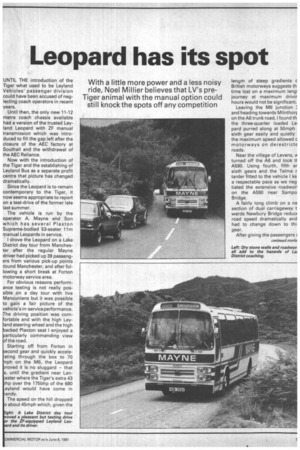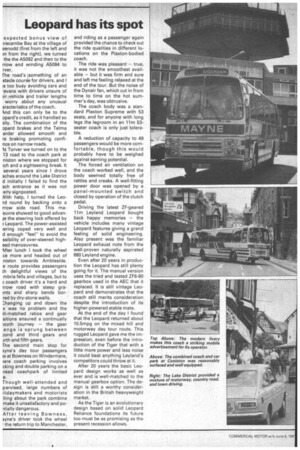Leopard has its spot
Page 59

Page 60

If you've noticed an error in this article please click here to report it so we can fix it.
With a little more power and a less noisy ride, Noel Millier believes that [V's preTiger animal with the manual option could still knock the spots off any competition
UNTIL THE introduction of the Tiger what used to be Leyland Vehicles' passenger division could have been accused of neglecting coach operators in recent years.
Until then, the only new 11-12 metre coach chassis available had a version of the trusted Leyland Leopard with ZF manual transmission which was introduced to fill the gap left after the closure of the AEC factory at Southall and the withdrawal of the AEC Reliance.
Now with the introduction of the Tiger and the establishing of Leyland Bus as a separate profit centre that picture has changed dramatically.
Since the Leopard is to remain contemporary to the Tiger, it now seems appropriate to report on a test-drive of the former late last summer.
The vehicle is run by the operator A. Mayne and Son which has several Plaxton Supreme-bodied 53-seater 11m manual Leopards in service.
I drove the Leopard on a Lake District day tour from Manchester after the regular Mayne driver had picked up 39 passengers from various pick-up points mund Manchester, and after following a short break at Forton motorway service area.
For obvious reasons performance testing is not really possible on a day tour with live Mancunians but it was possible to gain a fair picture of the vehicle's in-service performance. The driving position was corm ortable and with the high Leyand steering wheel and the high acked Plaxton seat I enjoyed a articularly commanding view f the road.
Starting off from Forton in econd gear and quickly acceleating through the box to 70 ph on the M6, the Leopard roved it is no sluggard — that s, until the gradient near Lanaster where the Tiger's extra 43 hp over the 175bhp of the 680 eyland would have come in andy.
The speed on the hill dropped o about 45mph which, given the length of steep gradients c British motorways suggests th time lost on a maximum leng' journey at maximum drivir hours would not be significant.
Leaving the M6 junction and heading towards Milntho4 on the A6 trunk road, I found th the three-quarter loaded Le. pard purred along at 50mph sixth gear easily and quietly the maximum speed allowed c motorways on derestricte roads.
Near the village of Levens, vl turned off the A6 and took A590. Using fourth, fifth ar sixth gears and the Telma r tarder fitted to the vehicle I ke a respectable pace as we neg tiated the extensive roadworl on the A590 near Sampo Bridge.
A fairly long climb on a ne section of dual carriageway t wards Newbury Bridge reducE road speed dramatically and had to change down to thi gear.
After giving the passengers C continued overle
expected bonus view of )recambe Bay at the village of eenodd lfirst from the left and m from the right), we turned the the A5092 and then to the rrow and winding A5084 to rver.
ihe road's isomething of an stacle course for drivers, and I is too busy avoiding cars and -evens with drivers unsure of ,rvehicle and trailer lengths worry about any unusual aracteristdcs of the coach.
5,nd this can only be to the opard's credit, as it handled so sily. The combination of the opard brakes and the Telma arder allowed smooth and re braking promoting confince on narrow roads.
Torver we turned on to the 13 road to the coach park at niston where we stopped for ich and a sightseeing break. It several years since I drove aches around the Lake District U initially I failed to find the ach entrance as it was not ,arly signposted.
Nith help, I turned the Leord round by backing onto a rrow side road. This maeuvre showed to good advanje the steering lock offered by 3 Leopard. The power-assisted iering coped very well and d enough "feel" to avoid the ssibility of over-steered higheed manoeuvres.
kfter lunch 1 took the wheel ce more and headed out of niston towards Ambleside, e route provides passengers th delightful views of the mbria fells and villages, but to coach driver it's a hard and rrow road with steep grants and sharp bends borred by dry-stone walls.
:hanging up and down the x was no problem and the ill-matched ratios and gear sitions ensured a continually loath journey — the gear ange is sprung between ond and third gears and nth and fifth gears.
The second main stop for lyne's day tour passengers ts at Bowness on Windermere, iere coach parking involves cking and double parking on a nked coachpark of limited e.
Though well-attended and pervised, large numbers of didaymakers and motorists Iling about the park combine make it unsatisfactory and poitially dangerous.
After leaving Bovvness, 3yne's driver took the wheel the return trip to Manchester, and riding as a passenger again provided the chance to check out the ride qualities in different locations on the Plaxton-bodied coach.
The ride was pleasant — true, it was not the smoothest available — but it was firm and sure and left me feeling relaxed at the end of the tour. But the noise of the Dynair fan, which cut in from time to time on the hot summer's day, was obtrusive.
The coach body was a standard Plaxton Supreme with 53 seats, and for anyone with long legs the legroom in an llm 53seater coach is only just tolerable.
A reduction of capacity to 49 passengers would be more comfortable, though this would probably have to be weighed against earning potential.
The forced air ventilation on the coach worked well, and the body seemed totally free of rattles and creaks. A well-fitting power door was opened by a panel-mounted switch and closed by operation of the clutch pedal.
Driving the latest ZF-geared Vim Leyland Leopard bought back happy memories — the vehicle includes many vintage Leopard features giving a grand feeling of solid engineering. Also present was the familiar Leopard exhaust note from the well-proven naturally aspirated 680 Leyland engine.
Even after 20 years in production the Leopard has still plenty going for it. The manual version uses the tried and tested ZF6-80 gearbox used in the AEC that it replaced. It is still vintage Leopard and demonstrates that the coach still merits consideration despite the introduction of its higher-powered stable mate.
At the end of the day I found that the Leopard returned about 10.5mpg on the mixed hill and motorway day tour route. This rugged Leopard gave me the impression, even before the introduction of the Tiger that with a little more power and less noise it could beat anything Leyland's competitors could throw at it, After 20 years the basic Leopard design works as well as ever and is well-matched to the manual gearbox option. The design is still a worthy consideration in the British heavyweight market.
As the Tiger is an evolutionary design based on solid Leopard Reliance foundations its future too must be as promising as the present recession allows.












































































































